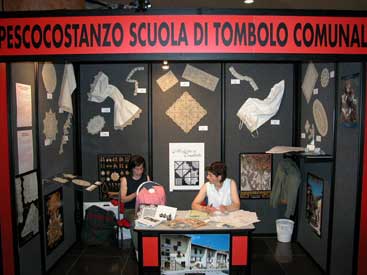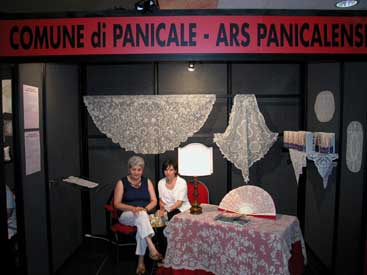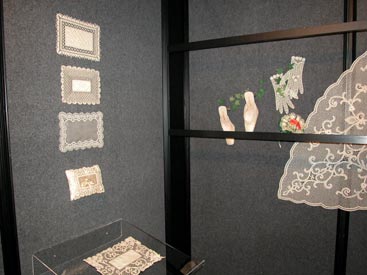

Merletto Al tombolo di Pescocostanzo Detail
Ars Panicalensis Ricamo has mano known Détail tulle
International forum of Rimini (Italy)
Lace with the spindles of Pescocostanzo
Historical description
Bobin lace, here called "Trina" was introduced in Pescocostanzo by craftsmen
from Lombardy around 1600. Since, the women have continued to practise this art from
generation to generation, up to present days.
The lace school was created in 1992 and located in the ancient Palazzo Fanzago, garantees
the continuation of this heritage with represents an economic resource and above all
cultural identity.
Technical Description
For a long time, imagination had made its appearance in interpretation of the suggestive
drawings. In particular in the jewels as earrings in filigrames, completely typical of
Pescocostanzo. Laces of 15th are also reproduced.
In detail an impressive tombolo for this lacemaker of Pescocostanzo.
Embroidery on tulle of Panicalensis
A fan in "Lierse", at least I believed it, was on the table. In
fact, while discussing with Paola Mattencci and Giuliana Marini, of the province
"Umbria" close to Perugia, I understood that it of it was nothing.
Indeed, they make initially their drawing that they cover with a glazed paper, then above
the mechanical tulle which one fixes using some points on the owner. Then, it is the
embroidery on tulle with the needle, quite simply. I already spoke you about the
"tulle poinct" which one also carries out with the needle on tulle, but here,
the result is completely different bus one embroiders while following the drawing on
tulle. One can also use a cordonnet to emphasize the reasons. It was something again, very
interesting to discover.
Historical description
The tulle embroidery of panicale is derived from antique local tradition as shown by
the pieces produced in th couvents and still preserved in our churches.
This technique widespread in the years 1800 after the invention of mechanical loom for
tulle in 1809, was a fast way of producing pieces similar to needle lace. In the
Twenties, the method was re-examined and improved by Anita Belleschi Grifoni. Anita based
a school of embroidery on tulle named "Ars Panicalensi". That allowed many
inhabitants of Panicale to practise this art nouveau.
Technical Description
The execution of the embroidery requires initially the preparation of the work: to build
the drawing on a support (oil-paper), to pose tulle on this drawing, and then to review
embroidery to the needle with various points in order to reproduce the required effect.
The flowers, medallions, birds of the paradise, volutes... are the principal reasons for
the "Ars Panicalensis".
 |
 |
Merletto Al tombolo di Pescocostanzo Detail |
Ars Panicalensis Ricamo has mano known Détail tulle |
************
The lace of Offida
We met our friends of Offida. Elvira (on the left) and Mariella (on the
right). They work both with the museum of Offida, but I you will speak again about it very
soon.
Here composition of their stand centered on the marriage. On left, a choice for the
cushions for alliances, with dimensioned, the unit veils, shoes, gloves of course the lace
whole. Then, a whole of "candy box" for dragees, the fine linen room and finally
one finishes by the handkerchief of marriage. Elvira makes broad and long lace cloth,
Mariella, an "Ancient" silk lace. What struck me, it is that lace is carried out
with a utility aim: cloths, tablecloths, bed-spread, curtains... whereas for the majority
of the lacemakers, lace is rather framed or preserved preciously.
In Offida, in this moment, it is the "race with the range". Indeed, the topic of the 5th annual contest was announced on May 1. The judgements are given on August 1. In short, 3 months to carry out a new range to gain the "Gold Spindle". Only, the native lacemakers of Offida can take part in this contest. But when one knows that about the 5000 inhabitants of the village, one does not count less than 2000 lacemakers...........
Historical description
The bobbin lace of Offida acn traded back to 1400's, as evidenced by a shirt of San
giacomo of Marca preserved still today. From this period, and the following century,
religious lace held a very important place in Offida.
In 1728, to greatly increase the use of local products, a petition was send with the Pope
Benedict XIII to prevent the introduction of lace from other localities into Papal state.
In 1800 the lace achieved its highest quality but it was only in th following century that
the lace of Offida became recognised in the European and extra-european markets.
Technical Description
Before beginning work, fixing on the trade the paperboard with the pricking and the
drawing of lace to be reproduced. Work consists of 2 movements: to cross and twist. These
two repetitive movements make the last one and the 1/2 last. It results from this from
other points imaginations. The various points carried out are "it Punto Rinascimento,
it Punto Venezia ED it Pizzo Antico".
 |
 |
| Fusello d' Oro |